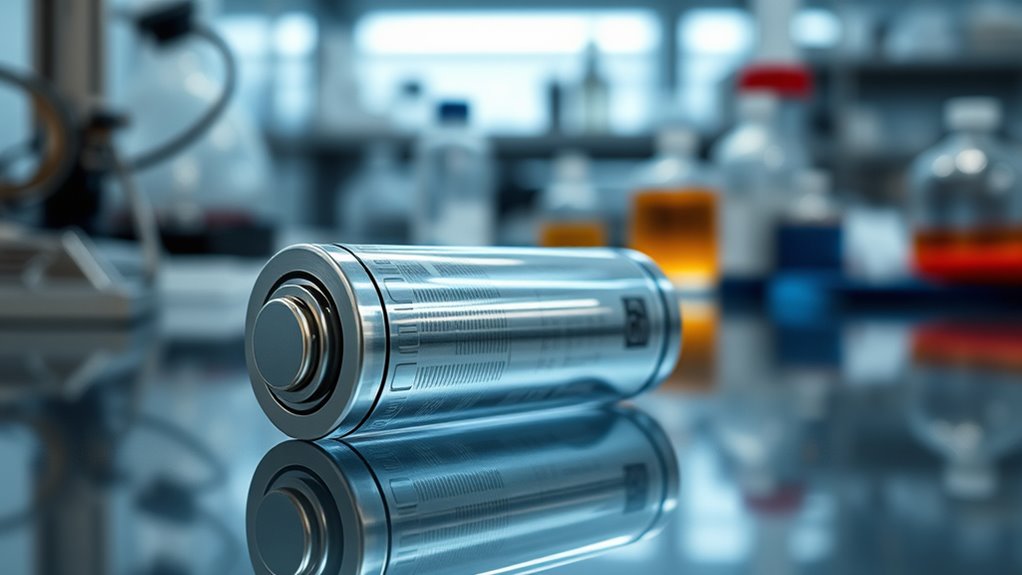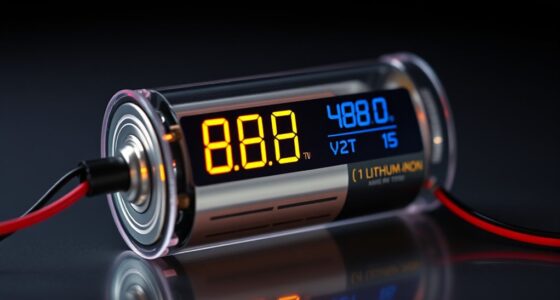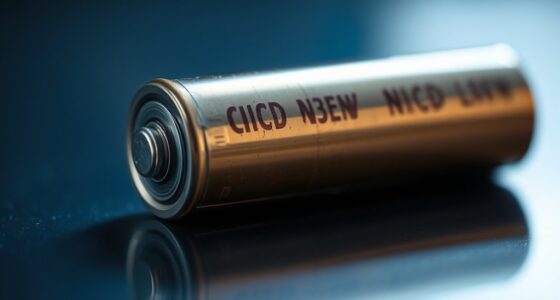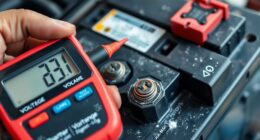Lithium-air batteries offer the potential for very high energy densities, comparable to gasoline, which could revolutionize electric vehicles and portable devices. They work by converting oxygen from the environment, but face major hurdles like electrode degradation, unstable discharge products, and slow oxygen diffusion. Overcoming these challenges involves advanced materials and design strategies. If you explore further, you’ll discover how scientists are tackling these issues to unleash the full promise of lithium-air technology.
Key Takeaways
- Lithium-air batteries have theoretical energy densities comparable to gasoline, promising significant advancements over current battery technologies.
- Their main challenges include electrode degradation, electrode stability issues, and complex electrochemical reaction management.
- Oxygen diffusion limitations within the porous cathode hinder reaction kinetics and overall battery performance.
- Electrode corrosion and pore clogging by discharge products reduce capacity and lifespan.
- Innovations in electrode design, protective coatings, and pore control are essential to address these challenges effectively.

Have you ever wondered how future batteries could deliver much higher energy densities than current technologies? Lithium-air batteries hold tremendous promise because they theoretically offer energy densities comparable to that of gasoline, which could revolutionize energy storage for electric vehicles and portable electronics. But turning this potential into reality hinges on overcoming several critical challenges, especially related to electrode stability and oxygen diffusion.
Electrode stability is fundamental to the performance and lifespan of lithium-air batteries. Unlike traditional batteries, where electrode materials remain relatively stable, lithium-air batteries involve complex electrochemical reactions that can degrade electrodes over time. The cathode, often composed of porous carbon, faces issues like corrosion and the formation of insoluble discharge products, which can clog pores and reduce conductivity. This instability not only diminishes capacity but also shortens the battery’s operational life. To make lithium-air batteries viable, researchers are exploring advanced electrode materials that resist degradation, such as protective coatings or novel composite structures. These innovations aim to maintain electrode integrity during repeated charge-discharge cycles, ensuring consistent performance and longevity.
Electrode stability is crucial for lithium-air batteries’ performance and longevity.
Oxygen diffusion presents another significant hurdle. Since the cathode relies on oxygen from the surrounding environment, efficient oxygen transport into the electrode’s porous structure is essential. If oxygen molecules cannot diffuse rapidly and uniformly, the reaction kinetics slow down, limiting the battery’s power output and capacity. Moreover, inconsistent oxygen flow can lead to uneven discharge and formation of undesirable byproducts, which impair electrode function. To address this, scientists are designing optimized electrode architectures that facilitate faster oxygen diffusion, like creating controlled pore sizes and surface modifications that enhance oxygen permeability. Additionally, managing the formation and removal of discharge products, such as lithium peroxide, is critical to prevent pore blockage and sustain adequate oxygen access. Addressing electrode degradation through innovative material strategies is crucial for advancing lithium-air battery technology.
Solving these intertwined challenges requires a delicate balance. Improving electrode stability often involves introducing new materials or coatings that can withstand reactive oxygen species, while enhancing oxygen diffusion necessitates structural innovations that allow oxygen molecules to permeate efficiently without compromising electrode stability. The interplay between these factors determines whether lithium-air batteries can reach their theoretical energy densities in practical applications.
Frequently Asked Questions
How Long Do Lithium-Air Batteries Typically Last in Practical Applications?
In practical applications, lithium-air batteries typically last between 100 to 200 charge cycles, which translates to about 1 to 3 years of use. Your battery’s lifespan depends on degradation factors like electrode wear, electrolyte stability, and environmental conditions. Frequent cycling accelerates degradation, reducing overall lifespan. Proper maintenance and operating within recommended limits can help extend your lithium-air battery’s performance and delay capacity loss.
Are Lithium-Air Batteries Environmentally Sustainable and Recyclable?
You might wonder if lithium-air batteries are environmentally sustainable and recyclable. While they offer high energy potential, their environmental impact raises concerns due to the use of potentially toxic materials and recyclability challenges. Recycling processes are complex, and recovering lithium and other components efficiently remains difficult. Consequently, their sustainability depends on developing better recycling methods and minimizing environmental harm, making ongoing research essential for future eco-friendly battery solutions.
What Are the Safety Risks Associated With Lithium-Air Batteries?
You should know that lithium-air batteries pose significant safety risks, mainly due to fire hazards from their chemical instability. These batteries can spontaneously ignite if damaged or improperly handled, and their reactive nature makes them difficult to contain securely. The risk of chemical leaks or explosions increases with improper design or usage, so strict safety protocols are essential to prevent accidents and ensure safe operation.
Can Lithium-Air Technology Be Integrated Into Existing Battery Systems?
You can incorporate lithium-air technology into existing battery systems, but it faces significant integration challenges. System compatibility issues, such as differing voltage levels and electrode materials, require careful engineering adjustments. You’ll need to modify current designs to accommodate the unique chemistry of lithium-air batteries. While possible, these integration challenges mean that deploying lithium-air in standard systems demands substantial research and development efforts to ensure safety, efficiency, and reliability.
What Are the Costs Compared to Traditional Lithium-Ion Batteries?
Imagine balancing a scale; lithium-air batteries currently tip higher in potential but are heavier on your wallet. You’ll find the cost comparison unfavorable, mainly due to manufacturing challenges, which keep prices elevated compared to traditional lithium-ion batteries. While lithium-air promises greater energy density, the complex production process and limited scalability make it costlier now. As technology advances, those costs may stabilize, but for now, it’s a costly investment.
Conclusion
Imagine opening a treasure chest of energy hidden deep within lithium-air batteries. While they promise soaring theoretical capacities, challenges like instability and sluggish reactions act as locks we must carefully pick. You stand on the brink of a revolution in energy storage—where innovation can turn this powerful dream into reality. With perseverance, you’ll transform these promising batteries from fragile dreams into a radiant future, fueling your journey toward cleaner, more efficient energy.










